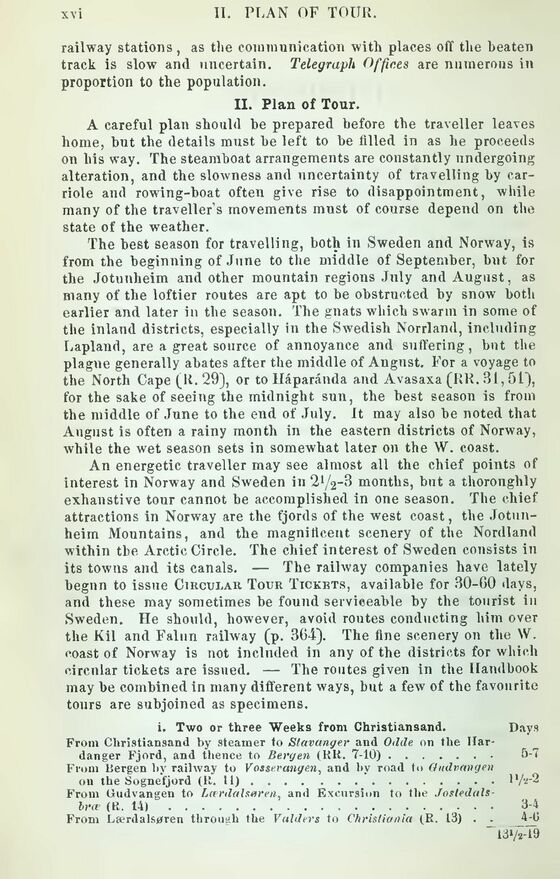
Full resolution (JPEG)
- On this page / på denna sida
- Introduction
- Pages ...

<< prev. page << föreg. sida << >> nästa sida >> next page >>
Below is the raw OCR text
from the above scanned image.
Do you see an error? Proofread the page now!
Här nedan syns maskintolkade texten från faksimilbilden ovan.
Ser du något fel? Korrekturläs sidan nu!
This page has been proofread at least once.
(diff)
(history)
Denna sida har korrekturlästs minst en gång.
(skillnad)
(historik)
railway stations, as the communication with places off the beaten
track is slow and uncertain. Telegraph Offices are numerous in
proportion to the population.
II. Plan of Tour.
A careful plan should be prepared before the traveller leaves
home, but the details must be left to be filled in as he proceeds
on his way. The steamboat arrangements are constantly undergoing
alteration, and the slowness and uncertainty of travelling by
carriole and rowing-boat often give rise to disappointment, while
many of the traveller’s movements must of course depend on the
state of the weather.
The best season for travelling, both in Sweden and Norway, is
from the beginning of June to the middle of September, but for
the Jotunheim and other mountain regions July and August, as
many of the loftier routes are apt to be obstructed by snow both
earlier and later in the season. The gnats which swarm in some of
the inland districts, especially in the Swedish Norrland, including
Lapland, are a great source of annoyance and suffering, but the
plague generally abates after the middle of August. For a voyage to
the North Cape (R. 29), or to Haparanda and Avasaxa (RR. 31,51),
for the sake of seeing the midnight sun, the best season is from
the middle of June to the end of July. It may also be noted that
August is often a rainy month in the eastern districts of Norway,
while the wet season sets in somewhat later on the W. coast.
An energetic traveller may see almost all the chief points of
interest in Norway and Sweden in months, but a thoroughly
exhaustive tour cannot be accomplished in one season. The chief
attractions in Norway are the fjords of the west coast, the
Jotunheim Mountains, and the magnificent scenery of the Nordland
within the Arctic Circle. The chief interest of Sweden consists in
its towns and its canals. — The railway companies have lately
begun to issue Circular Tour Tickets, available for 30-G0 days,
and these may sometimes be found serviceable by the tourist in
Sweden. He should, however, avoid routes conducting him over
the Kil and Falun railway (p. 364). The fine scenery on the \V.
coast of Norway is not included in any of the districts for which
circular tickets are issued. — The routes given in the Handbook
may be combined in many different ways, but a few of the favourite
tours are subjoined as specimens.
i. Two or three Weeks from Christiansand. Days
From Christiansand by steamer to Stavanger and Odde on the
Hardanger Fjord, and thence to Bergen (KK. 7-10)................. 5-7
From Bergen by railway to Vosserangen, and by road to Ondvangen
on the Sognefjord (R. 11)....................................l’A"2
From Gudvangen to Lærdalserrjm, and Excursion to the Josledals-
bra? (R. 14)................................................. M
From Lærdalsøren throuah the Valders to Christiania tR. 13) . _4-0
<< prev. page << föreg. sida << >> nästa sida >> next page >>
Project Runeberg, Sat Dec 9 14:19:04 2023
(aronsson)
(diff)
(history)
(download)
<< Previous
Next >>
https://runeberg.org/baenosw89/0020.html



